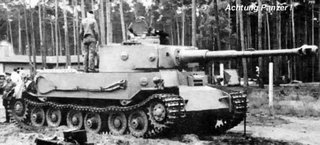Tiger.

This is coolbert:
German tank commanders such as the aces Michael Wittmann and Hyazinth von Strachwitz employed the "Tiger" tank of World War Two [WW2] fame with great efficiency.
The Tiger tank was a formidable weapons system when used by able hands.
Possessed very thick and virtually, for it's time, impenetrable frontal armor.
Possessed a very powerful gun that could destroy any existing enemy armor, Soviet or Allied. This gun was of the caliber 88 mm. Based on the famous German 88 mm flak gun. Having found the 88 mm anti-aircraft artillery piece to be eminently suitable for anti-armor warfare when used in a ground role, it was only natural to outfit the latest and most powerful German tank with such a gun as well.
The Tiger tank was a reaction to the realization on the part of the Germans that most of their armor vehicles were INFERIOR in quality to that of their adversaries, at least in the early stages of the war.
Both during the campaigns in France [1940], and in Russia [1941], German armor units fought adversaries whose tanks were both more numerous and of better quality. German success at armored warfare was due to the manner with which the Nazi commanders employed THEIR tanks. Rather than dispersing them to support the infantry, the German CONCENTRATED their tanks and focused their combined energy against enemy WEAK SPOTS. The German objective was to rupture the enemy defenses and create a breakthrough situation. Tanks would then rapidly advance with the intent of destroying enemy rear echelon units, service and service support, a collapse of the entire enemy front being the inevitable result.
"The German tanks that preceded the Tiger balanced mobility, protection, and firepower. They were sometimes outgunned by their opponents (at the time the best tank to put against enemy tanks was the Panzer III with its 50mm gun), but greatly superior German tactics offset this disadvantage."
[concentrated armored formations of German tanks were supported by Luftwaffe ground attack aircraft such as the Stuka which blasted a path through enemy defenses, creating the circumstances favorable for a breakthrough.]
Even when faced with superior Soviet tanks such as the T-34 or the KV tank [Klementi Voroshilov], German tank tactics used in the Russian campaign of 1941 were still successful. By AVOIDING Soviet strength and attacking WEAKNESS, German victories of prodigious proportions via armored assault were still possible.
NONETHELESS, the Germans quickly realized that the Soviet T-34 and the KV tank posed really serious problems for them. Problems for which a counter had to be devised.
"The Tiger had in part been a response to Soviet heavy tanks, namely the KV-1, as well as the medium T-34 which had some notable successes against lighter German tanks of the time."
"There was great consternation when it was discovered that the Soviet tanks were superior to anything available to the Wehrmacht".
That counter was the Tiger tank.
The Tiger tank WAS a successful counter to the Soviet machines. Thicker armor and a more powerful gun meant that the Tiger was more or less impervious to frontal attack while being able to destroy opponents at hitherto unheard of ranges. ONE Tiger was worth TEN opposing tanks??!!
The Tiger, however, was NOT without it's drawbacks. Drawbacks that in some cases were very serious.
* Such a heavy machine as the Tiger WAS ponderous. All that armor and large gun meant that the Tiger was far heavier than existing German tanks. Mobility was sacrificed for protection and killing power. THE TIGER WAS SLOW!! LACKED SPEED AND MOBILITY PERIOD!!
"The Tiger I represented a new approach that emphasized firepower and armor at the expense of mobility."
[tanks since their onset as a military weapon have been an engineering compromise of mobility, protection and firepower. The successful tank is the best engineering compromise of all three aspects.]
* The Tiger was rushed into production and had a lot of teething problems. Mechanical breakdown and a lot of maintenance meant down-time and a lack of availability for combat.
"The Tiger had reliability problems throughout its service life; Tiger units frequently entered combat understrength due to breakdowns. It was rare for any Tiger unit to complete a road march without losing vehicles due to breakdown."
* The Tiger could not be produced in large enough numbers to make a difference. Took a lot of time to build and only a limited number were produced.
"A major problem with the Tiger was its very high production cost. During the Second World War over 40,000 American Sherman and 58,000 Soviet T-34s were produced, compared to 1,350 Tiger I and 500 Tiger II tanks."
The Tiger was formidable. When handled by able crews and commanders, could wreak a lot of destruction. But when faced with overwhelming numbers, as it was, the Tiger did not make the difference the German had hoped it would.
"During the Second World War over 40,000 American Sherman and 58,000 Soviet T-34s were produced"
Simple as that!!
coolbert.
Labels: Germans

0 Comments:
Post a Comment
Subscribe to Post Comments [Atom]
<< Home